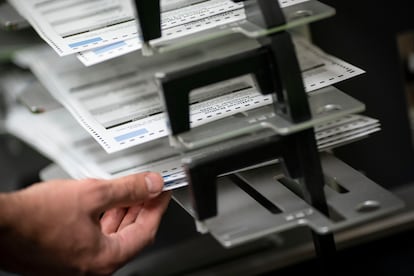2024 US elections: How to vote with an absentee ballot if you live abroad
United States citizens who live abroad can receive an absentee ballot to vote in the next presidential election

According to the U.S. Vote Foundation, there are roughly 2.9 million eligible American voters living abroad, with most residing in Canada and the United Kingdom. These U.S. citizens are covered by the Uniformed and Overseas Citizens Absentee Voting Act (UOCAVA) of 1986, which makes overseas citizens able to vote absentee in federal elections. In order to start the absentee voting process, they need to submit a Federal Post Card Application (FPCA) to their election officials. After being approved, the voter receives the ballot which they will have to return before the state’s return deadline.
The U.S. Department of State recommends submitting the FPCA at the beginning of the year or at least 45 days before an election in order to have time to process the request and solve any problems. It also advises submitting an FPCA each year and if the citizen moves or changes their address, email or name.
How to request an absentee ballot
U.S. citizens who live abroad have to register with local election officials in their state of voting residence and request an absentee ballot. The FPCA serves for both.
The FPCA can be obtained by using the Federal Voting Assistance Program website online assistant, but it also can be picked up along with the state’s requirements from U.S. embassies and consulates around the world. The applicant has to fill in some personal data like their name, previous names, contact information, birthdate, last U.S. residence address, and current address.
The Department of State advises completing the ballot carefully, legibly and as early as possible before returning it to local election officials in time to meet the deadlines. Voters can return their completed ballots through local mail, fax, e-mail, an express courier service, or they can drop it off at the nearest U.S. embassy or consulate. It must be mailed with a postage-paid envelope or with sufficient U.S. postage.
Several states permit voters to track their absentee ballot status, and most of them often notify of a problem with processing the ballot due to different problems.
45 days before the November general elections, the state sends the voter a blank ballot at the address provided or via email.
If the voter wants to verify their registration, they can check the FVAP site for a directory of state voter registration verification websites where they can find their state and see if they’re registered, or they can write, call or email their local election officials directly.
Every state’s guidelines can be checked on the FVAP website.
What if I didn’t receive the ballot?
If the voter didn’t receive the ballot 30 days before an election, it’s necessary to complete a Federal Write-In Absentee Ballot. This document can be completed using an online assistant on the FVAP website, or the voter can ask for assistance at the nearest U.S. embassy or consulate. On this ballot, the voter must write in the candidates of their choice and send it signed to their local election officials.
Sign up for our weekly newsletter to get more English-language news coverage from EL PAÍS USA Edition
Tu suscripción se está usando en otro dispositivo
¿Quieres añadir otro usuario a tu suscripción?
Si continúas leyendo en este dispositivo, no se podrá leer en el otro.
FlechaTu suscripción se está usando en otro dispositivo y solo puedes acceder a EL PAÍS desde un dispositivo a la vez.
Si quieres compartir tu cuenta, cambia tu suscripción a la modalidad Premium, así podrás añadir otro usuario. Cada uno accederá con su propia cuenta de email, lo que os permitirá personalizar vuestra experiencia en EL PAÍS.
¿Tienes una suscripción de empresa? Accede aquí para contratar más cuentas.
En el caso de no saber quién está usando tu cuenta, te recomendamos cambiar tu contraseña aquí.
Si decides continuar compartiendo tu cuenta, este mensaje se mostrará en tu dispositivo y en el de la otra persona que está usando tu cuenta de forma indefinida, afectando a tu experiencia de lectura. Puedes consultar aquí los términos y condiciones de la suscripción digital.
More information
Archived In
Últimas noticias
Most viewed
- Oona Chaplin: ‘I told James Cameron that I was living in a treehouse and starting a permaculture project with a friend’
- Sinaloa Cartel war is taking its toll on Los Chapitos
- Reinhard Genzel, Nobel laureate in physics: ‘One-minute videos will never give you the truth’
- Why the price of coffee has skyrocketed: from Brazilian plantations to specialty coffee houses
- Silver prices are going crazy: This is what’s fueling the rally











































